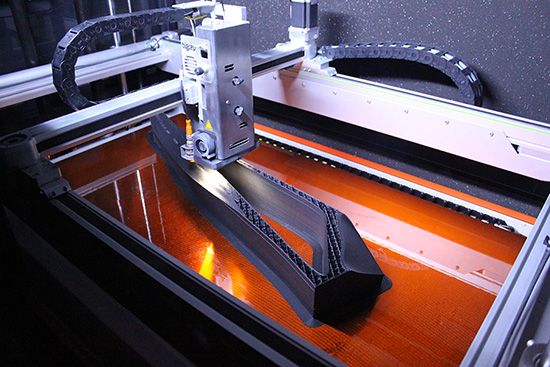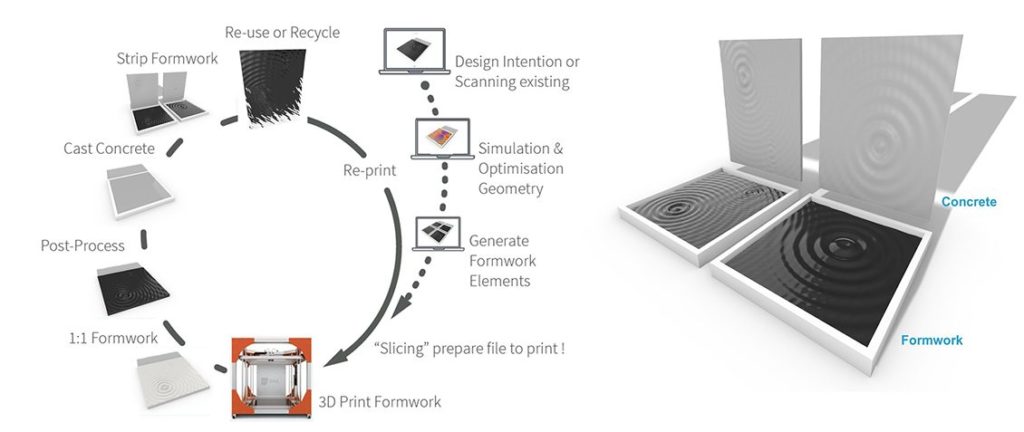Additive construction is building up in a big way, but as Executive Editor Joris Peels has noted, the real power of 3D printing in the architecture, engineering and construction (AEC) segment may be for the production of concrete formworks. Just as additive manufacturing (AM) has enabled new cost and production efficiencies in manufacturing via 3D printed tools and fixtures, 3D printed formwork may offer similar benefits to construction. For that to work, however, AEC businesses will have to leverage large-scale 3D printers.
Two German companies that seem to have understood all of the above are chemical giant BASF and large-format 3D printer manufacturer BigRep. The latter has partnered with the 3D printing business of the former, Forward AM, to develop a new 3D printing material for just such an application. CONCRETE FORMWORK is a filament designed for 3D printing custom molds with which to fill with cement for AEC use.
The partners note that molds can account for 40 to 60 percent of a construction budget, particularly when it comes to more complex geometries. For instance, organic shapes may require double-curved surfaces and incorporating cavities into designs are impossible. In turn, skilled technicians are necessary to create custom formwork, that in turn increases costs, lead times and material waste.
Just as 3D printing can be used to produce custom molds for any number of manufacturing methods to get around said problems, a material like CONCRETE FORMWORK would open up the same benefits for the fabrication of custom concrete molds. One could imagine such printer manufacturers as Cincinnati Inc., Thermwood, and others offering similar products, but BigRep has the backing of the largest chemical company in the world to target the AEC segment with its large-scale 3D printers.

A BigRep 3D printer producing a large-scale mold with CONCRETE FORMWORKS material. Image courtesy of BigRep.
“We are excited to work with Forward AM to bring more solutions to the architecture and construction industry,” said Dr. Sven Thate, Managing Director of BigRep. “Our customers are seeing huge gains in terms of cost and speed thanks to our large-format machines and the new CONCRETE FORMWORK filament. Our solutions are opening the doors to many new possibilities.“

A curved concrete element made with CONCRETE FORMWORKS material from Forward AM. Image courtesy of BigRep.
BigRep’s machines can 3D print up to one cubic meter in build volume to create complex molds three times more quickly than traditional methods and at a fraction of the cost, according to the company. The material was specifically created to work on BigRep’s machines and to handle the formation of concrete elements.
“At Forward AM, we developed a highly dimensionally stable, rigid formwork material, especially tailored to work seamlessly on the BigRep’s large-format3D printers. We are excited to be able to deliver this ready-to-use, end-to-end fabrication solution for bespoke formwork,” says François Minec, Managing Director BASF 3D Printing Solutions.
To showcase the potential of the material, Forward AM and BigRep created “Bespoke Stair at Nest Step2”, a concrete staircase designed by DBT at ETH Zürich with ROK, SW Umwelttechnik, and WaltGalmarini. The structure will be incorporated into the NEST building to be constructed at EMPA in Zürich. The steps are 50 percent lighter than traditionally made elements, due to the ability of 3D printing to create complex geometries.
As with 3D printed tooling, concrete formworks may not be as instantly exciting as a completely, 3D printed building, but it is a more immediately accessible method for AM to enter the AEC space, carrying its benefits with it. So, while 3D printed molds assist construction all around, users will begin to understand the benefits of additive construction as a whole, perhaps adopting direct concrete 3D printing for other elements where 3D printed formworks don’t makes sense (e.g., 3D printing wind turbine foundations). In the end, it might have a bigger impact on the cost of buildings than entirely 3D printed buildings, as well.
Subscribe to Our Email Newsletter
Stay up-to-date on all the latest news from the 3D printing industry and receive information and offers from third party vendors.
You May Also Like
3D Printing Unpeeled: New Arkema Material for HP, Saddle and Macro MEMS
A new Arkema material for MJF is said to reduce costs per part by up to 25% and have an 85% reusability ratio. HP 3D HR PA 12 S has been...
3D Printing News Briefs, January 20, 2024: FDM, LPBF, Underwater 3D Printer, Racing, & More
We’re starting off with a process certification in today’s 3D Printing News Briefs, and then moving on to research about solute trapping, laser powder bed fusion, and then moving on...
3D Printing Webinar and Event Roundup: December 3, 2023
We’ve got plenty of events and webinars coming up for you this week! Quickparts is having a Manufacturing Roadshow, America Makes is holding a Member Town Hall, Stratafest makes two...
Intuitive Machines Debuts $40M Hub for Lunar Ambitions and 3D Printing Tech
Best known for its pioneering work in lunar exploration and its development of the Nova-C lunar lander, Intuitive Machines (Nasdaq: LUNR) has marked yet another significant milestone. The leading space...

































